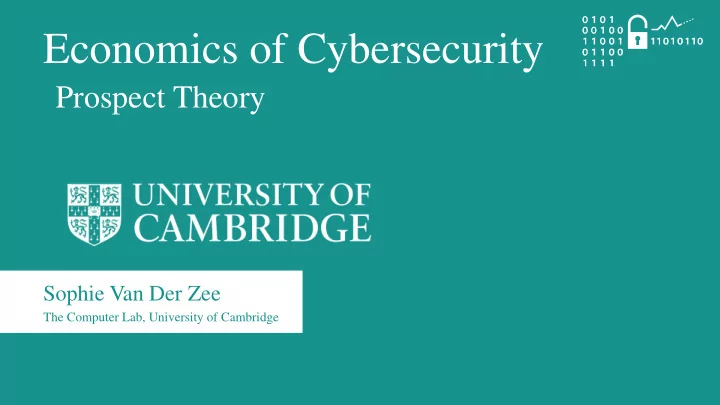

Economics of Cybersecurity Prospect Theory Sophie Van Der Zee The Computer Lab, University of Cambridge
Decision-making People constantly make decisions involving different levels of risk and uncertainty Psychologists and economists have tried to capture human decision-making under risk in theoretical models to explain and predict people’s behavior
Expected utility theory (1) Daniel Bernoulli, 1738 Dominant theory until the mid 20th century Three important concepts: Utility (psychological value) Wealth (current state) Rational choice model
Expected utility theory (2) Utility Utility does not increase proportionately with the amount of money Example: The first pound extra is worth more than the 10 th or the 100 th A gamble should be assessed by its expected utility, not by expected absolute value
Expected utility theory (3) Wealth Utility is dependent on the current state of wealth Example: £10 is worth more to someone who only has £10 than to someone who has £100, a £1000 or £100,000 Wealth is included when calculating the best option
Expected utility theory (4) Model of rational choice The utility of potential outcomes is weighted by the probability of its occurrence Example: 60% chance of + £10 = £ 6 50% chance of + £10 = £ 5 People are expected to choose the best option
Expected utility theory (4) Model of rational choice The utility of potential outcomes is weighted by the probability of its occurrence Example: 60% chance of + £10 = £ 6 50% chance of + £10 = £ 5 People are expected to choose the best option
Issues with expected utility theory Although we could make decisions based on rational cost- benefit analyses, we often don’t for two reasons: 1. People have an irrational tendency to be less willing to gamble with profits than with losses prospect theory 2. We use mental shortcuts instead of calculating all possible options heuristics
Prospect theory (1) Kahneman & Tversky (1979) People do not always make rational decisions because they value gains and losses differently Centred around loss aversion “A bird in the hand is worth two in the bush”
Prospect theory (2) We experience stronger emotions during loss than during gain Loss aversion
Prospect theory (3) People are risk-seeking when faced with potential loss, while they are risk averse and prefer certainty for gains
Example (1) – “Asian Flu” There are 2 programs to battle a disease In program A, 200 people will be saved In program B, there is a 1/3 probability that 600 people will be saved, and a 2/3 probability that no one will be saved
Example (1) – Expected utility theory There are 2 programs to battle a disease In program A, 200 people will be saved In program B, there is a 1/3 probability that 600 people will be saved, and a 2/3 probability that no one will be saved Absolute outcome is the same
Example (1) – Prospect theory There are 2 programs to battle a disease In program A, 200 people will be saved In program B, there is a 1/3 probability that 600 people will be saved, and a 2/3 probability that no one will be saved Risk averse in gain scenario
Example (2) There are 2 programs to battle a disease In program C, 400 people will die In program D, there is a 1/3 probability that no one will die, and a 2/3 probability that 600 people will die
Example (2) – Expected utility theory There are 2 programs to battle a disease In program C, 400 people will die In program D, there is a 1/3 probability that no one will die, and a 2/3 probability that 600 people will die Absolute outcome is the same!
Example (2) – Prospect theory There are 2 programs to battle a disease In program C, 400 people will die In program D, there is a 1/3 probability that no one will die, and a 2/3 probability that 600 people will die Risk seeking when facing potential loss
Prospect theory (4) People do not always make a rational choice of the best option Experiments show that people deviate from rationality in a consistent, predictable manner One reason is that they value gains and losses differently “It ain’t what you say, but the way that you say it”
Thank you for your attention! Please post any questions you may have on our discussion forum.
Recommend
More recommend